How to Pick the Best Blog Name Ideas in 2024 (Ultimate Guide)

In 1597, William Shakespeare famously asked, ‘What’s in a name?’
Nearly 500 years later, it turns out that names are indeed important, especially to run a successful blog.
Nailing your blog name can be tricky.
After all, there are more than 600 million blogs today and 1.7 billion websites.
In addition, once you choose the name and domain for your blog you are stuck with it for the long haul.
Creating a “brandable” name for your blog is one of the first crucial steps in establishing your online identity.
The name isn’t simply a word.
It’s a reflection of what you envision the blog to become, what it seeks to deliver, and what it hopes to embody.
To help you pick a great blog name, this step-by-step guide will take you through:
- Things to consider when choosing your blog name.
- Ways and methods to name your blog.
- Top blog name generators to choose your blog name.
- And more.
Keep reading to learn how to come up with a blog name and choose the best one for your site.
Things to Consider When Brainstorming Blog Name Ideas.
Here are some things to keep in mind while choosing and brainstorming blog name ideas.
1. The Importance Of Great Research.
Wernher Von Braun, an aerospace engineer, and space architect, once said, “Research is what I do when I don’t know what I’m doing.”
In other words, research should be the starting point for any planned blogging activity.
It helps point out the advantages and risks of the unknown.
While picking a new blog name is not rocket science, it’s still a topic worthy of considerable research.
At the very onset, try to find out:
- Who are the blogger leaders in your subject area?
- How many followers or subscribers do they have?
- What are the types of names they use?
- Do they run paid blogs or free ones?
When you absorb all these, you’ll know what sort of audience you have for the particular subject matter.
You’ll also know if the audience is willing to pay to get access to such information.
You can gather insights about the type of information your competitors uphold and identify areas that are not being adequately addressed.
Not just your blog name, it can also help you discover ideas for your upcoming blog titles.
Having the right title could impact the number of viewers and your click-through rate.
This, in turn, can affect the monetization capability of the blog, so that’s an area that requires specific stress.
Only proper research can help with that.
Doing something uncommon while naming your blog can also work.
For example, most travel or adventure blogs have titles that have specific keywords.
You usually come across names with keywords like a vagabond, outdoor, crazy, travel, etc.
You are highly unlikely to come across titles that are meaningless yet catchy, like Google.
If you decided to start a similar blog and name it something weird, it’d be a certainty to attract eyeballs straight away.
2. What is Your Motivation to Start A Blog?
Once your research is complete, it’s time to reflect: Why do you want to start a blog in the first place?
There can be numerous reasons for this.
Some bloggers wish to build a blogging business to create a primary income source.
Some want to run a blog to make money as a steady passive income source.
Others simply want to communicate to the world about something you’re passionate about.
Simply put, it’s essential to identify the mission and vision of the blog you’re about to start.
Once you understand that, it becomes significantly easier to know where to begin your search for a name.
Your reason for starting a blog will help you zero in on a relevant name for the blog.
It may be serious or quirky – it doesn’t matter.
A relevant name can still work wonders when it comes to drawing readers’ attention.
The main motive should be to consistently provide the readers with the value that can make a difference in their lives.
3. Consider Your Niche.
It’s essential to consider the niche when picking a blog’s name or the area you will be writing about.
If you are yet to choose a perfect blog niche, make sure to do it before you pick your blog name.
Ultimately, you want to pick a name that feels right to you.
When selecting your blog name, make sure you think about the audience that may come to visit your site and how that could affect their perception.
For instance, imagine your audience is business people looking for free tips on improving their skills.
In that case, they would be looking for specific keywords that make sense in your niche.
If your blog name isn’t relevant to your niche or what it’s about, you could end up losing potential readers.
At the same time, if your blog name is too relevant (or niche-specific), you could lose out on reaching a larger audience.
So, make sure it’s relevant to your niche and can still reach a larger audience.
Pat Flynn’s Smart Passive Income is a good blog name that resonates with its niche.
The domain/company name gives you an inkling that the blog is about generating passive income. Not just income – but passive income.
So, it’s relevant to his content but not too niche-specific (like Smart Passive Income for Aerospace Engineers would be) that it won’t reach potential readers.
4. Conduct Gap Analysis.
The first step included identifying your competitors and the areas on which they write.
Now, conduct a gap analysis to determine topics in your domain you can exploit.

Image Credit: Process.st
Usually, these are sectors that your fellow bloggers have missed or have failed to recognize as important.
These gap areas can help you create a niche for yourself and make inroads into untapped yet important information points.
To pinpoint the gap, you need to understand the potential value addition for readers no one else is thinking about.
This makes your blog indispensable to readers and enhances your blog subscriptions while fostering deep-rooted relationships.
The gap analysis also ensures you select the perfect name for the blog, one that makes the audience want to know more.
At the same time, it will make them appreciate that this isn’t something they have come across before – which makes what you have to offer more valuable.
5. Probing the Readers.
Despite extensive research about the blog’s subject matter, identifying and attracting the right audience can be difficult.
The Cynefin Framework can show the way in such scenarios.
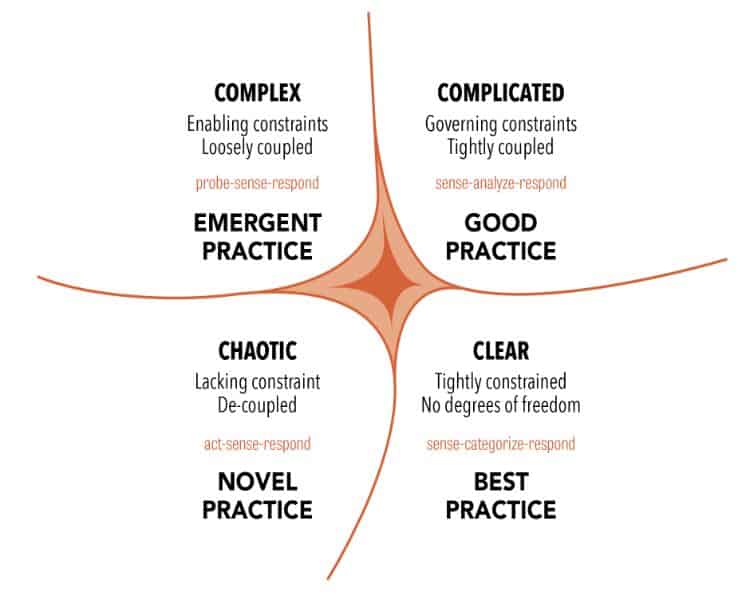
Image Credit: Wikipedia.org
Your situation will fall under the “Complex” tangent.
In such cases, bloggers must probe deeper into who the target audience can be and recognize what they want.
Once the probe begins to provide results, you can sense the shape of your readers.
After that, it’s only a matter of time before you reach out and respond.
Sometimes, the target audience will be more dynamic and subject to change as time progresses.
In such cases, the ‘probe-sense-respond’ set of activities must be continuous instead of one-time.
As the type of readers evolves, so must your brand of blogging.
To ensure subscription renewals and minimize abandonment, the focus must be on generating client-oriented content.
The first step is selecting a mutually beneficial name, which will retain its popularity even with a changing audience base.
6. Branding.
Like other businesses, branding is crucial for the long-term sustainability of a blog.
The difference between great brands and mediocre brands is the amount of emphasis the former put on self-branding.
But, with superior branding, it’s now one of the most sought-after brands in the world.
“Nike,” which means the winged Greek Goddess of Victory, sought to empower its patrons with a sense of power and motivation.
They tried to correlate the sound of speed and movement with the sweet scent of success.
Their branding campaigns, led by the famous ‘swoosh’ symbol, became an instant sensation.
Kodak is another example.
Despite having no meaning to its name, Kodak is one of the most recognizable companies in the world.
In the end, the aim is to make the consumers remember your blog’s name and recognize the brand from amongst thousands of others.
7. Keep it Concise.
When you choose your blog’s name, it needs to be memorable, easy to pronounce, and type.
It should have positive connotations, as we already know that first impressions are everything.
It should also be concise to make sure readers are not having a hard time reading or memorizing your blog name.
8. Avoid Infringing on Other Brand’s Trademarks.
It’s crucial to ensure that your blog name is unique and no other blogger has its copyright.
The reason for this is that you can get in trouble with the United States Patent and Trademark Office (USPTO), The Blogger’s Alliance, or other copyright protection groups if you are using a name with their trademarked word on your blog title.
One way to protect yourself from copyright infringements is by using online sites like NOLO to find out if your desired business name is available to use.
Top Tips and Methods to Name Your Blog.
Here are some quick tips and techniques to use while naming your blog.
1. Refer to the Dictionary.
Dictionaries are a treasure trove of words and information about how to use them.
They alphabetically capture all the words in a particular language and act as a ready reference for enthusiasts.
They can provide you with the perfect environment for inspiration, capturing words you are unfamiliar with.
Orenda Tech is an excellent example of a very uncommon blog title taken from a dictionary.
You likely heard the word “Orenda” for the very first time. It means an invisible spiritual power inherent in people.
The Oxford English Dictionary is a great place to start in this regards.
2. Use Alliteration.
The whole point is to have something that rolls off the tongue – something people are going to remember.
That’s where alliteration comes into the picture.
Someone conversant with the English language will know about alliteration, the magic of playing with words.
Alliteration is a fun way to come up with names for your blog that are creative and memorable.
It’s the use of two or more words starting with the same letter.
It’s one of the best ways to instantly pique the reader’s interest and help them perceive the blog topic.
It’s also a proven method to get a catchy name.
Hence, the technique is highly used by some of the most popular blogs and brands.
Some examples are:
- Dunkin’ Donuts
- Coca-Cola
- TED Talks
- American Airlines
- Donald Duck
- Peter Parker
- Savoring Simplicity
Not only will an alliterated blog name help you find content marketing success, but it’s also fun to craft.
3. Merged Portmanteau.
Merged portmanteau words are impressive combinations of two separate terms that form an entirely new word.
Also known as blending or meshing words, a portmanteau is a popular way of creating brandable names.
They’re not just words; they are a way to describe a new term that combines multiple concepts behind it.
For example, smog is a combination of smoke and fog, brunch is a combination of breakfast and lunch, and freemium combines free and premium.
It can add more creativity to your naming process.
You pick two related words, blend them into one, and get a catchy name.
You can also use synonyms, misspellings, acronyms, and phonetic variations to come up with unique blog names.
4. Read Books and Blogs.
As they say, “Reading is to the mind what exercise is to the body.”
Quite rightly so, as reading books and blogs can open your eyes to endless possibilities.
It might just help you find that elusive, perfect name for your blog that you’ve been searching for.
In fact, there are plenty of precedents in history.
Many book titles got inspired by names and quotations found in other books, most notably the Bible.
The title of John Steinbeck’s magnum opus, “East of Eden,” comes from the Old Testament, Book of Genesis, line 4:16.
Similarly, the title of William Faulkner’s 1930 work, “As I lay dying,” comes from the Greek poem, “The Odyssey.”
5. Pun Intended.
Puns are fun, not to mention Alfred Hitchcock’s famous dialogue about them, “Puns are the highest form of literature.”
Blog titles with puns are a sure-shot way to intrigue and provoke readers.
The main trick about using a pun while naming your blog is to ensure it relays the correct information and doesn’t confuse the intended audience.
If your blog name meets this criterion, you have a winner.
For example, Budget Bytes is a blog about recipes.
Campmor is an outdoor blog.
Both are using puns in their title to significant effect.
6. Add a Dash of Humor.
Blog titles peppered with humor can be a great way of capturing the readers’ interest.
Not only can they make the readers smile, but they also occupy their mind space for a long time.
People with funny bones can appreciate and identify with humor, which can lead to greater acceptability.
Some famous blogs with names that are based on humor are the Pregnant Chicken for expecting parents and The Lazy Baker for baking recipes.
7. Words That Make No Contextual Sense.
Apple, a technology company, is one of the most recognizable brands in the world.
In today’s world, people identify high-tech gadgets with this name much more than its namesake fruit.
Similarly, Amazon identifies with the world’s biggest e-commerce company far more than the world’s biggest rainforest.
In both cases, apples and rainforests have no bearing on the work these companies do.
There are many such examples in the blogging space, where bloggers use completely unrelated titles to significant effect.
Readers tend to remember unrelated titles more often, and it proves to be a successful branding strategy.
Although unconventional, this technique can be pretty useful.
8. Use Made-up Names.
Made-up names have come to make and define companies for years.
When taken out of context, some of the most well-known brands today are meaningless, like Google, Vitol, and Nvidia.
It proves that as long as the name is catchy, it doesn’t necessarily need to have a meaning to succeed.
If the service and products (in this case, blog content) are excellent, having a made-up name won’t matter.
A great advantage is that since the name will not signify anything in the thesaurus, it can catch the readers’ attention; and that is the first thing bloggers want – attention.
9. Use Your Own Name/Nickname.
This is a terrific way to attract readers, especially if you’re a renowned blogger or an authority on the subject matter the blog deals with.
A personal blog with the author’s name announces to the world that the blog will contain valuable information in the author’s area of expertise.
That said, it does help if the author’s name is somewhat uncommon since it tends to stand out in stark contrast.
My own blog AdamEnfroy.com is an eponymous blog.
10. Specialism/Niche.
This method is similar to using names or nicknames while naming your blog.
However, instead of using the author’s name, you use the name of the topic or the blog’s niche.
The subject domain of the blog is the selling point and not the blogger.
Readers can identify with these blogs at a single glance since they directly highlight their scope.
It helps captivate and transfix readers.
This is particularly helpful in the case of subjects with an inherent appeal, like:
- Fashion blog names
- Travel blog names
- Adventure blog names
- Beauty blog names
- Food blog name ideas
- And more.
For example, when you hear the blog names Expert Vagabond and Nomadic Matt, you can quickly relate to all things outdoor and adventure.
No one needs to specify what the blogs are about since their names are enough to give you an idea.
11. Include Target Keywords.
Many business owners brand their company with the name of their product or service.
With a blog, you have another option.
You can pick a name that will get readers to your blog through search engines and help them understand what they can expect from your blog – all without having to read one word of content.
Many experts, including Google’s John Mueller, claim that keywords do not significantly impact domain name rankings.
However, adding keywords is still a great way of specifying the blog’s subject matter.
Once your readers see a specific keyword in your domain name, they’ll know right away what the blog is all about.
12. Use Blog Name Generators.
A blog name generator will allow you to pick exciting names that work for your website without putting strain on your brain.
They especially prove to be convenient when you are having trouble coming up with anything on your own.
The best part about these domain name generators is that most of these domains are 100% available, so you won’t waste your time trying to register a domain that’s already in use.
They even direct you to the web hosting providers selling the names you pick.
I handpicked some of the best blog name generators for you to use.
Top Blog Name Generators.
Here are some of the best blog name generators to use today to find your perfect blog name:
1. Nameboy.
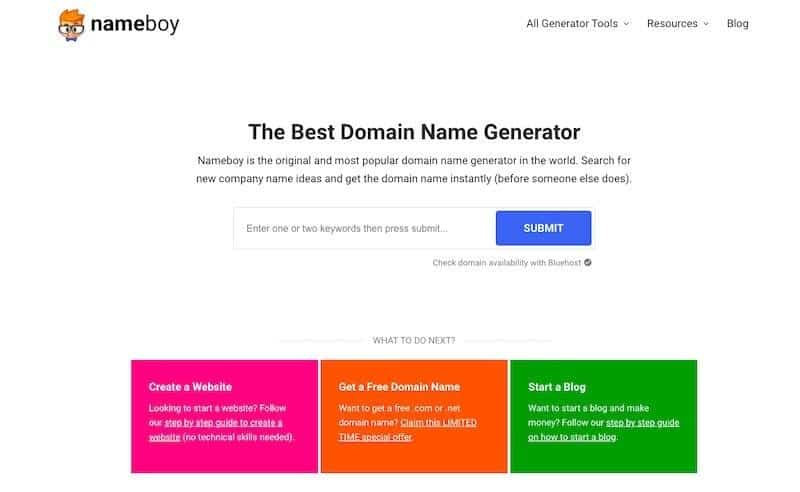
Nameboy is a free domain name generator tool for finding new domain names (with .com, .org, .net, .me, .in, or any other domain extensions you like) and blog names.
It initially came into existence in 1999, making it the original and one of the oldest domain name generators on the market.
You can also use Nameboy as a:
- Business name generator.
- Catchy website name generator.
- Store name generator.
- Brand name generator.
- Podcast name generator.
- Startup name generator.
- YouTube name generator.
Just type in one or two keywords in their search bar and hit the “Submit” button.
Nameboy will then suggest plenty of domain names based on the keywords you entered.
You can then browse through a list of blog names of the most recently updated domains and blogs in your own blog niche.
For example, let’s say you want to create a blog to write about marketing tips.
You can search the term “marketing blog.”
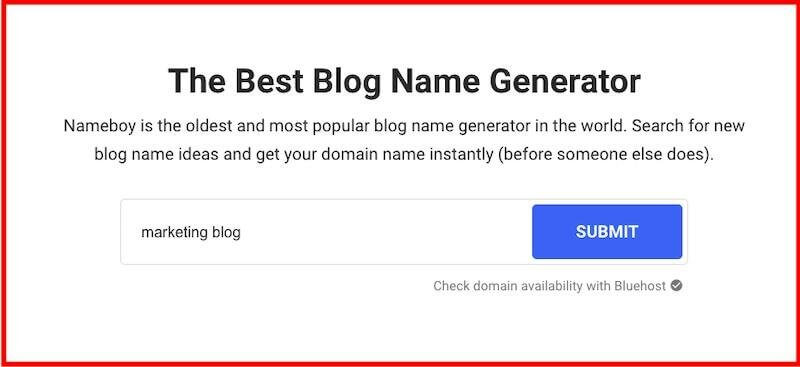
Here are the results I got after running the experiment:
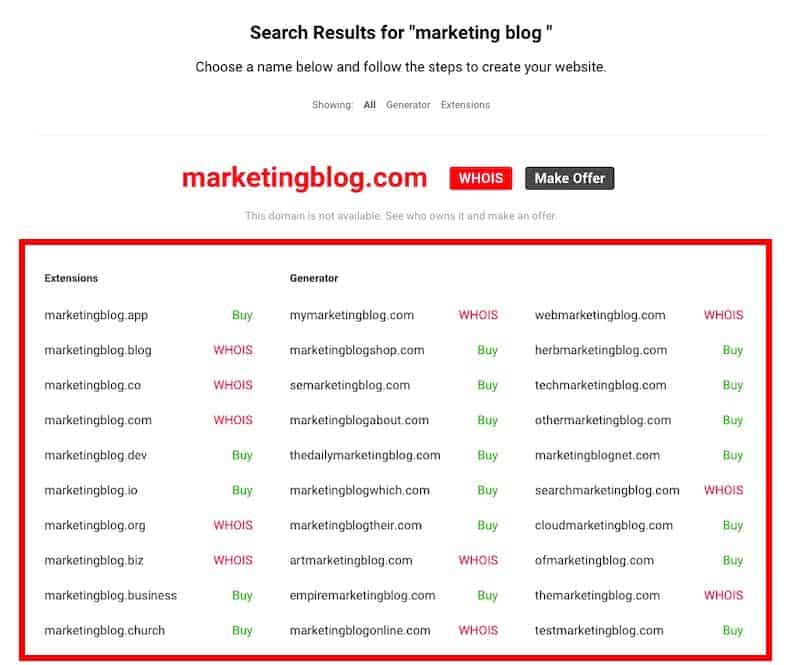
You can repeat the search until you find a suitable blog name to start your blog.
Click on the name you like to view more details and purchase the related domain name.
It will provide you with the best deals to register your blog’s domain name.
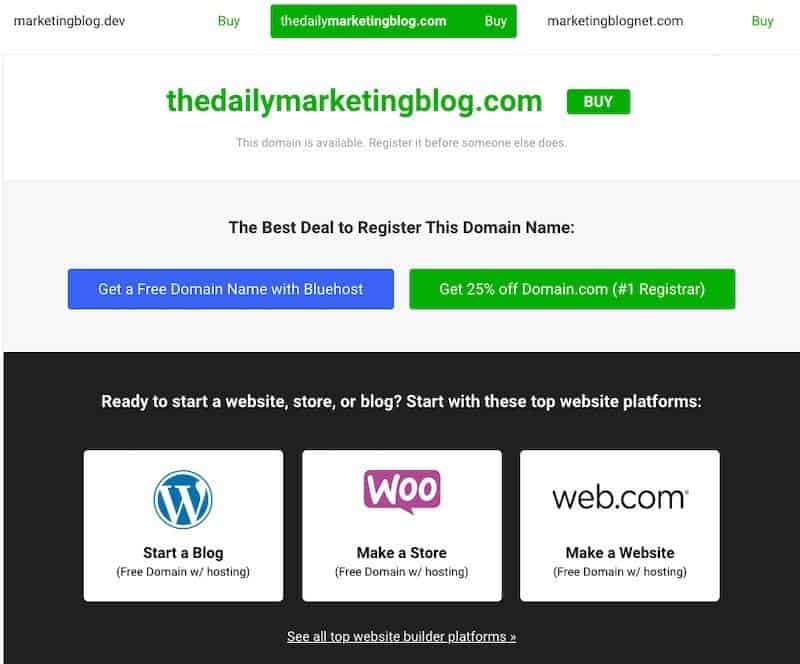
Nameboy will direct you to the WHOIS directory to determine who owns or manages that domain name if the name you like is unavailable.
WHOIS will also reveal their contact information, such as name, phone number, and address so that you can contact them right away.
2. Domain Wheel.
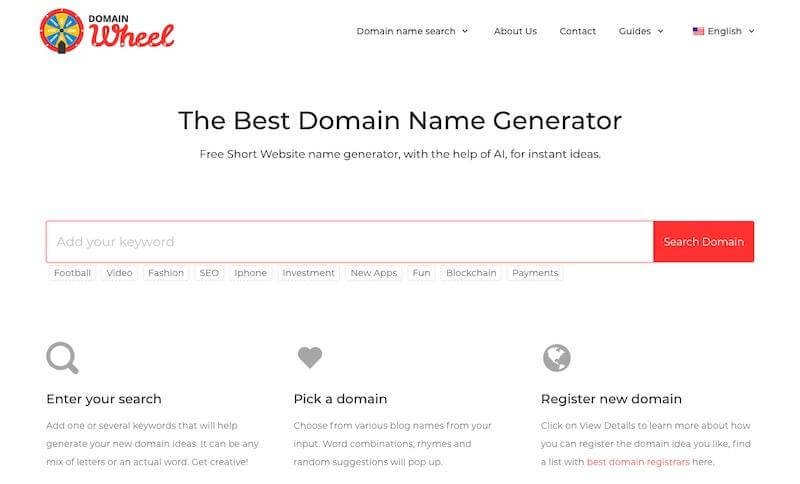
Domain Wheel is a free short blog name generator that leverages AI to come up with instant ideas.
It works similar to Nameboy.
Simply type a keyword or two or three keywords in the search box and click the “Search Domain” button.
DomainWheel combines the letters from different popular words to form a new word or brand name you can use for your blog.
It can do this over and over again, without ever repeating itself.
For the sake of this experiment, let’s say you want to start a blog based on Coffee.
I typed in the keyword “Coffee” in the search tab.
Here are the results:
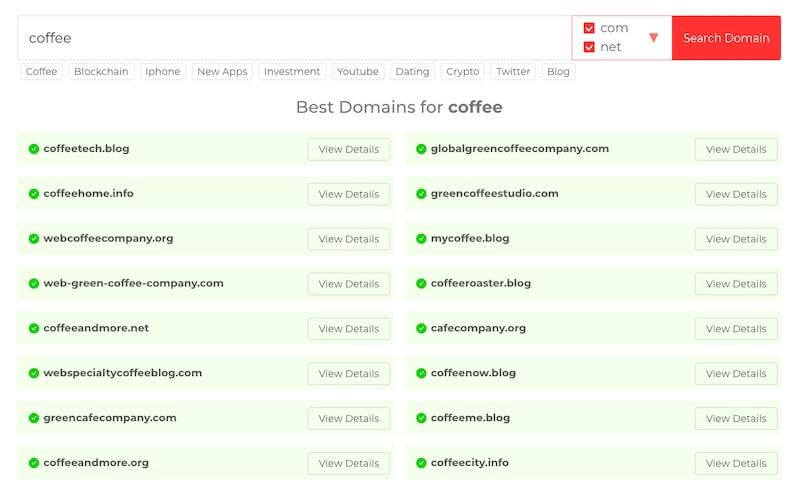
Domain Wheel even generates blog names with random ideas.

At first, these terms might seem irrelevant to your keyword search.
But a catchy name might prove to be more lucrative than a keyword-based name.
Many brands that are household names today did start with unique names.
Amazon, eBay, Reddit, etc., are some of the most significant examples.
If you scroll further, you’ll also come across some keywords related to yours by topic.
Random word combinations, suggestions, and rhymes will also pop up.
Finally, click on “View Details” to learn more about the name and where to register the domain for the blog name you liked.
3. WPBeginner Business Name Generator.
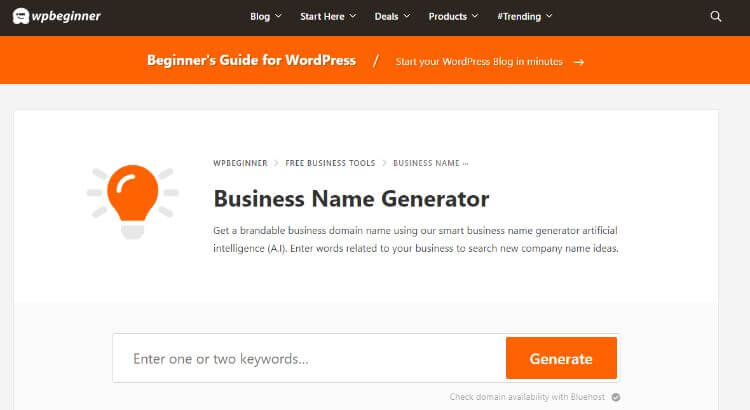
WPBeginner Business Name Generator is a smart, AI-based blog name generator that provides you with a brandable name.
Just like other tools, you’ll have to enter keywords related to your business or blog to search for relevant name ideas.
It will also check the domain name’s availability with Bluehost so that you can even register it right away.
Let’s say you want to start a lifestyle blog. I’m entering the keywords “Lifestyle tips” in the search bar.
Here are the results:
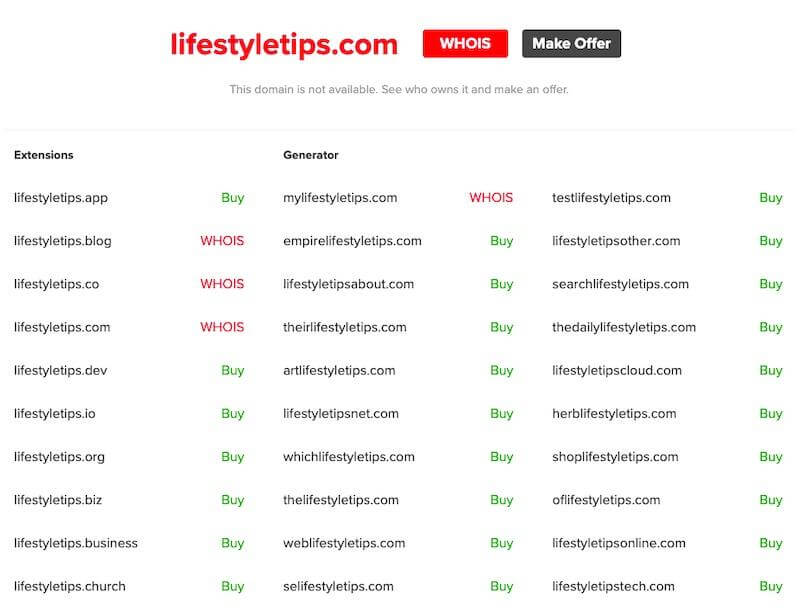
The green color indicates domain availability.
On the other hand, the unavailable names will come accompanied by their WHOIS link.
You can follow the link to see who owns the name you’re interested in and make an offer.
The available options also come with the best deals online.
You can also use the tool to generate a name for your new YouTube channel, ecommerce store, WordPress site, etc.
4. BustAName.
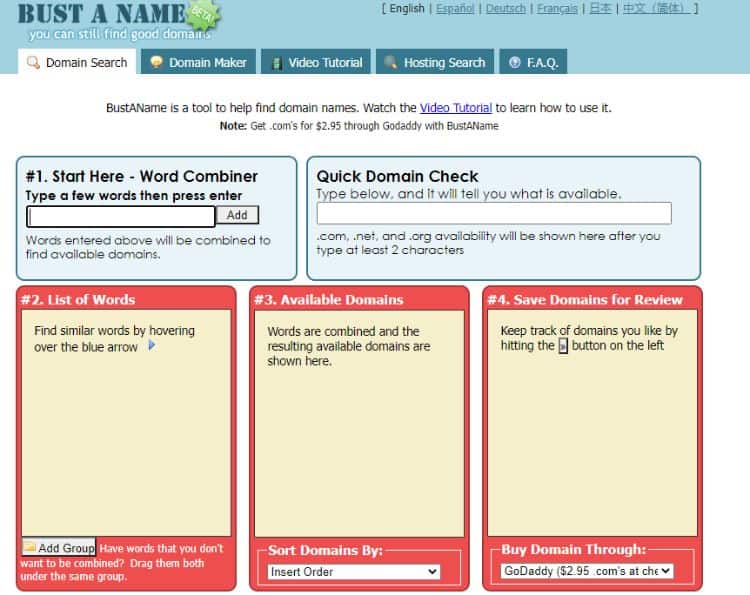
BustAName is a free, randomized blog name generator that will give you plenty of ideas for your blog name.
What makes this site stand out is its ability to combine different variations of keywords that you provide.
You also have various sorting options, making your domain choosing process easier.
Once you pick a domain name, you can also buy it immediately through the domain registrar of your choice.
5. NameStation.
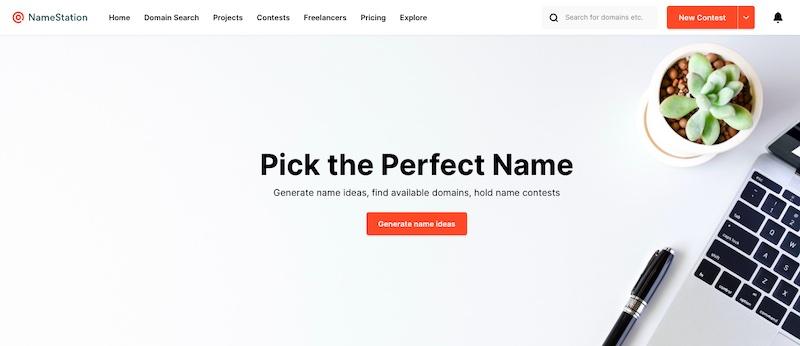
NameStation is a domain name generator that helps you pick name ideas, find available domains, and even hold name contests.
You can start with searching your blog name similar to how you did with other name generators.
However, NameStation also asks you to specify what you are naming.
Let’s enter the keywords “Coffee Addict.”
These are the results I got:
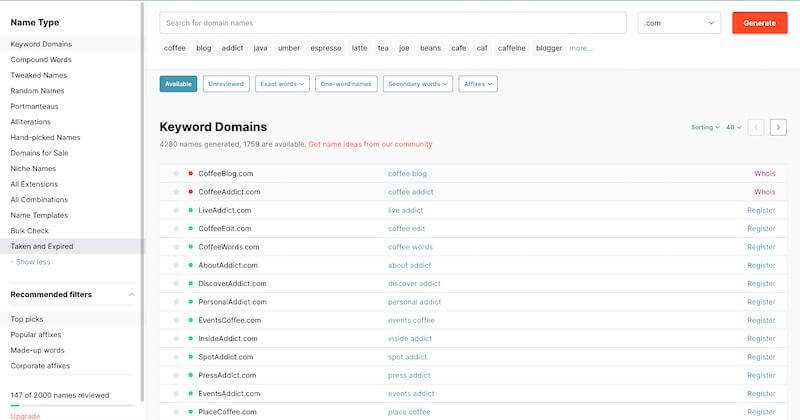
The names with the red dot mean they are unavailable. You’ll get directed to the Whois directory to procure those names from the current owner.
The available names will redirect you to the domain name provider to register for the name.
You can also filter your results by one-word names, popular affixes, made-up words, corporate affixes, and top picks.
There are also options to search for different name types, such as:
- Compound Words
- Tweaked Names
- Random Names
- Portmanteaus
- Alliterations
- Niche Names
However, unlike other tools, you’ll have to sign up (albeit for free) before you see your results.
The ability to hold name contests is an additional bonus.
You’ll get more than a hundred unique, available names for your blog from a community consisting of over 300 contributors.
Then you can pick the option you like from the whole bunch.
These are some of their latest winners:
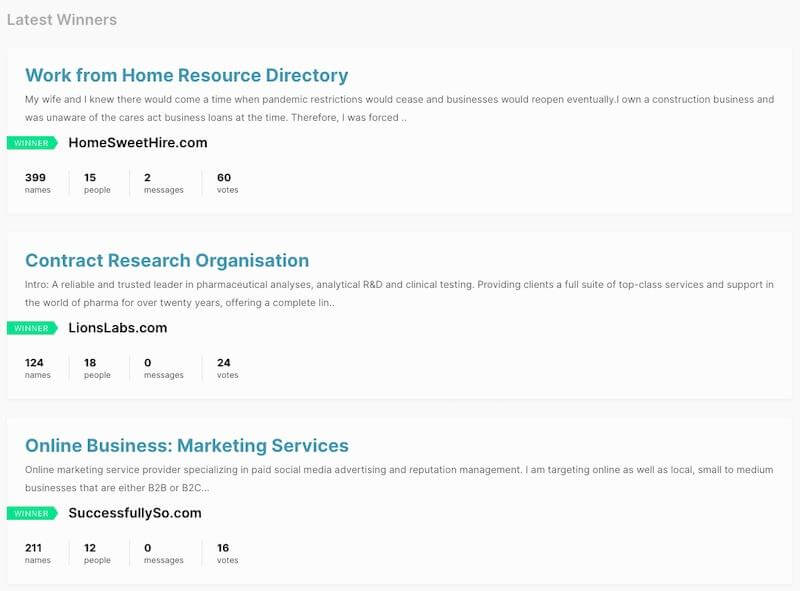
Note that it’s a paid feature.
You’ll have to pay $40 for a Standard contest, where you can expect more than 150 entries in 1-3 days. Alternatively, highlight your contest for $50 to receive over 200 entries.
Blog Name Ideas – FAQ
What is a good blog name?
Choosing through a bunch of blog name ideas can feel like a really daunting process. What I have found to work the best is taking the approach I call “The Brand of You”, because you are your own brand. This blog is a perfect example of that because it is just my name.
This way I don’t have to figure out the perfect blog name, and I keep the ability to remain flexible with my content and entire blogging strategy.
What are examples of blog names?
Good examples of blog name ideas depend on the type of blog you want to start.
If you want the blog to be a non-personal brand-style blog, then having something to do with your niche in the name would be ideal.
For example, there is a fitness blog called NerdFitness.com, and on this blog, he writes for an audience of people who want to be fit but identify as “nerds”.
What is a good lifestyle blog name?
The best lifestyle blog name is your own name!
You are your own lifestyle, right? So instead of brainstorming the perfect blog name ideas for endless hours, you can quickly and easily get the name out of the way by going with your own.
Summary.
The right name can help you shape your content strategy, as well as influence the way readers perceive your business.
Creative blog names capture the reader’s attention and establish trust.
On the other hand, a jarring or confusing name can cause confusion and derail the user experience.
If you need a blog name, you should look for inspiration in various areas while brainstorming.
It can be a website or forum thread with funny names, social media, random scribbles in your notebook, or music lyrics with weird combinations of words.
In other words – go wherever creative ideas are born.
It’s also okay if you don’t want to brainstorm a catchy blog name yourself.
You can use blog name generators Nameboy, NameStation, Panabee, etc., to come up with a blog name.
By now, you should have an idea of what to look for when choosing a blog name.
Follow the tips and hacks mentioned to generate a potential name for your blog.
Looking for other posts about blogging?
- Learn how to start a brand new blog for beginners with my step by step how to start a blog guide.
- Trying to figure out which platform to blog on? Check out my post reviewing the best blogging platforms.
- Looking for ways to better monetize your blog? Learn how I make money blogging in the 2020’s.




